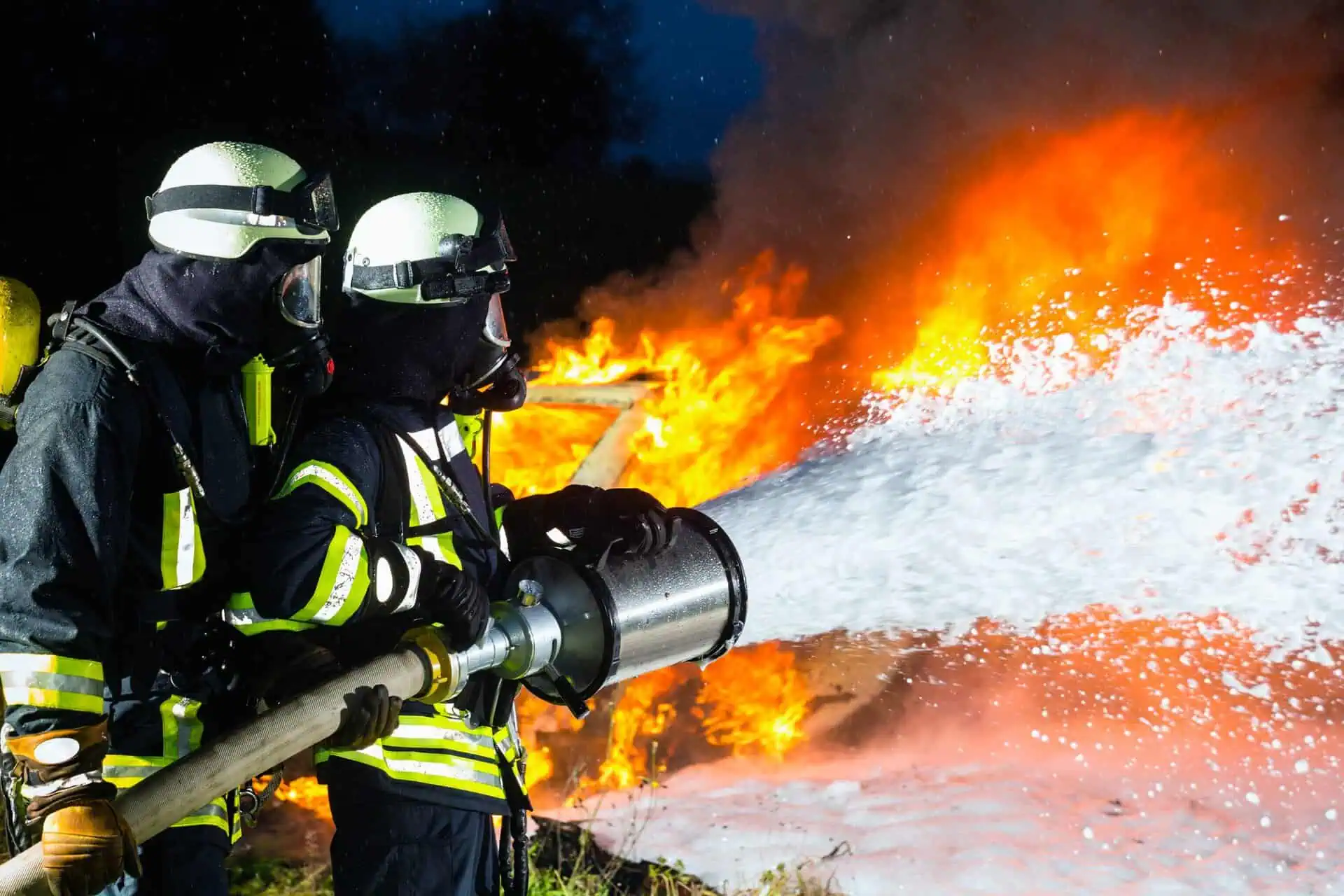Firefighting Foam & PFAS: The Hidden Dangers
- Last Updated: June 12th, 2025

Attorney Jessica Paluch-Hoerman, founder of TruLaw, has over 28 years of experience as a personal injury and mass tort attorney, and previously worked as an international tax attorney at Deloitte. Jessie collaborates with attorneys nationwide — enabling her to share reliable, up-to-date legal information with our readers.
Legally Reviewed
This article has been written and reviewed for legal accuracy and clarity by the team of writers and legal experts at TruLaw and is as accurate as possible. This content should not be taken as legal advice from an attorney. If you would like to learn more about our owner and experienced injury lawyer, Jessie Paluch, you can do so here.
Fact-Checked
TruLaw does everything possible to make sure the information in this article is up to date and accurate. If you need specific legal advice about your case, contact us by using the chat on the bottom of this page. This article should not be taken as advice from an attorney.
Key takeaways:
- Firefighting foam, used by firefighters contains per- and polyfluoroalkyl substances (PFAS), such as PFOA and PFOS, which contain fluorine. These PFAS compounds are highly persistent and do not easily break down over time, contributing to the foam's exceptional fire suppression capabilities.
- The ecological implications of PFAS contamination extend beyond immediate firefighting incidents, as these persistent chemicals can accumulate in soil, water bodies, and wildlife, disrupting ecosystems.
- Public awareness and advocacy play a vital role in pushing for stricter regulations, responsible disposal of firefighting foam, and research into safer alternatives to mitigate the hidden dangers posed by PFAS chemicals.
Firefighting Foam & PFAS: The Hidden Dangers
Firefighting foam: a crucial tool in fire safety or hidden danger?
You might be surprised to learn that this seemingly harmless substance contains toxic chemicals known as PFAS.
These per- and polyfluoroalkyl substances (PFOA) pose serious health and environmental risks when released into the environment through firefighting activities involving flammable liquids.
PFAS contamination from firefighting foam containing fluorinated chemicals, such as PFOA and PFOS, has become a pressing issue for firefighters and communities worldwide.
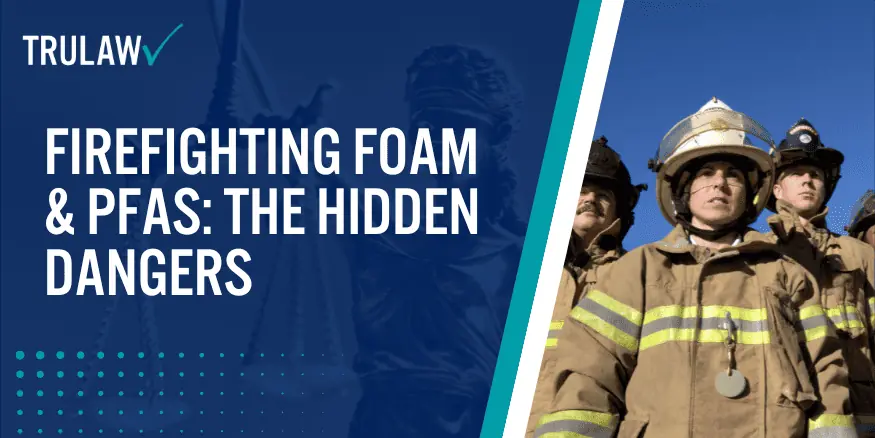
Water sources, including rivers, lakes, and groundwater, are particularly affected by these fluorinated chemicals, posing risks to both humans and wildlife.
The dangers of oil fires and the importance of fire extinguishment for firefighters are alarming.
The dangers associated with PFAS contamination, including fluorine-based compounds such as PFOA and PFOS, are not to be taken lightly.
Known as “forever chemicals,” these substances persist in the environment indefinitely and accumulate in our bodies over time.
It is important to address PFAS contamination by implementing safety measures and using fluoroprotein foam to combat fires involving flammable liquids.
Understanding the dangers posed by firefighting foam and its role in contributing to the contamination of drinking water is essential for protecting the health of firefighters and our ecosystems.
Join us as we explore the extent of health advisory dangers for firefighters, their impact on communities like Edwardsville, and what can be done to address this critical concern, including testing and implementing measures in municipal fire departments.
Table of Contents
Understanding the Persistence and Environmental Impact of Firefighting Foam
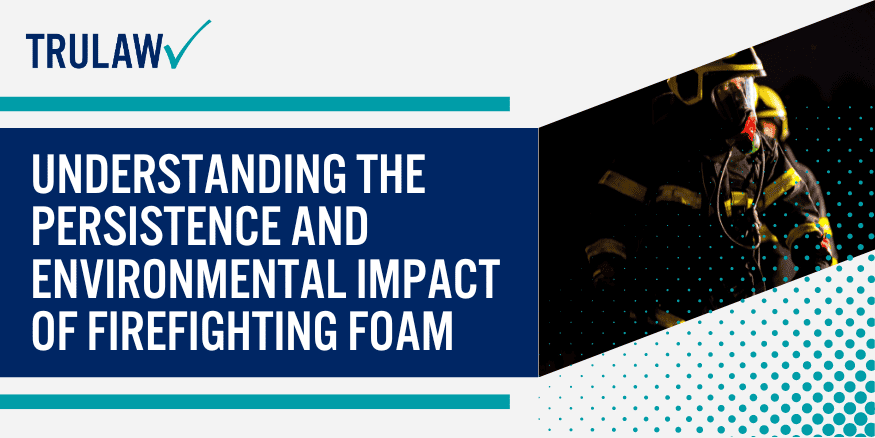
Firefighting Foam’s Longevity:
Firefighting foam, used by firefighters contains per- and polyfluoroalkyl substances (PFAS), such as PFOA and PFOS, which contain fluorine.
These PFAS compounds are highly persistent and do not easily break down over time, contributing to the foam’s exceptional fire suppression capabilities.
Once released into the environment during firefighting operations or accidental spills, firefighters can use chemical foam to combat the spread of PFAS chemicals.
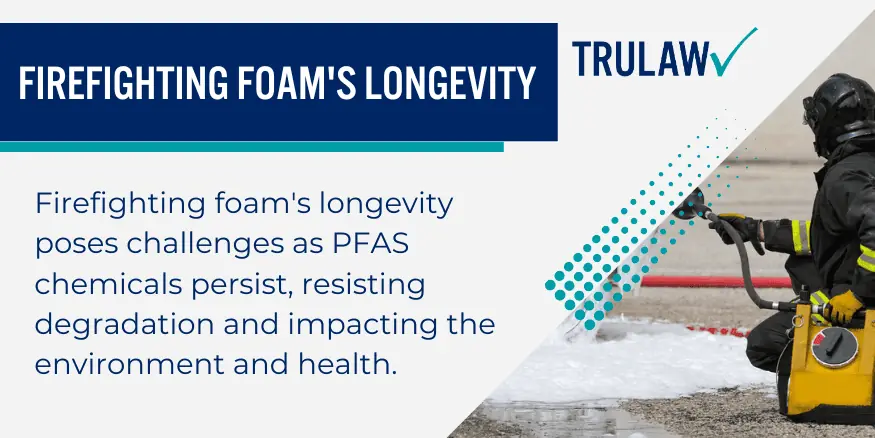
These chemicals can persist in drinking water for years or even decades.
The longevity of firefighting foam, including new foams containing PFOA and PFOS, poses a significant challenge for firefighters.
Traditional cleanup methods struggle to effectively remove these PFAS chemicals from contaminated sites due to their resistance to degradation.
This persistence means that even long after a fire has been extinguished, the potential environmental impacts and Firefighting Foam Health Effects containing PFOS, PFOA, and PFAS chemicals remain.
Contamination of Soil, Groundwater, and Surface Water:
When firefighting foam, including new foams containing PFOA and PFOS, is discharged during fire suppression activities, it often seeps into the ground and can contaminate both soil and groundwater.
These PFAS chemicals have been found to leach into soils and infiltrate deep underground water sources, posing a significant risk of widespread contamination for firefighters and communities.
Surface water bodies such as rivers, lakes, and ponds are also vulnerable to contamination from firefighting foam runoff containing PFOA and PFOS.
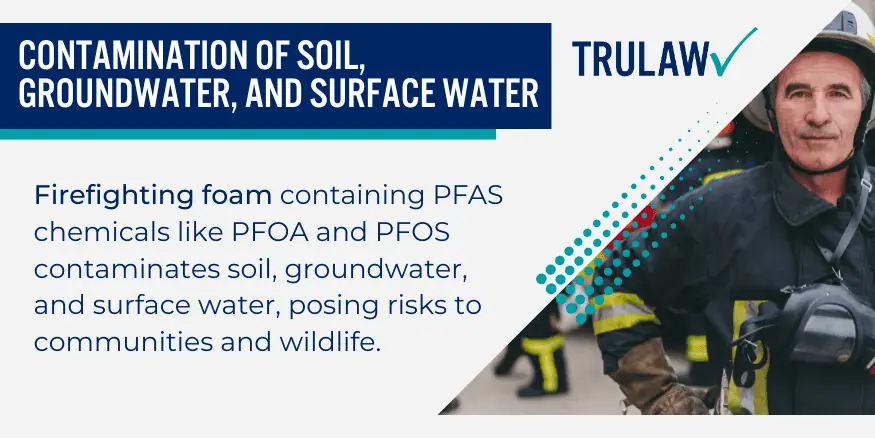
As rainwater washes away residual foam from affected areas or if there are direct discharges of the new foams into water bodies during emergencies, PFAS compounds enter these aquatic environments.
This contamination poses risks for human consumption and wildlife, including firefighters, that depend on these water sources.
The presence of cancer-causing substances such as PFOA and PFOS in the water further exacerbates the dangers.
Firefighting foam, including new foams, is crucial for firefighters in combating fires.
However, the use of firefighting foam, which may contain PFOA, poses long-lasting dangers to the environment.
The persistence of firefighting foam can lead to widespread contamination, as it remains in the environment for decades.
This article delves into the environmental impact of firefighting foam, specifically its persistence and how it affects soil, groundwater, surface water, wildlife, and aquatic ecosystems.
The use of firefighting foam containing PFOS, PFOA, and other PFAS chemicals can have detrimental effects on these natural systems.
Vulnerability of Wildlife and Aquatic Ecosystems:
Wildlife, aquatic ecosystems, and firefighters are particularly susceptible to the environmental impact of firefighting foam containing PFOS and PFOA.
These compounds have been shown to accumulate in the tissues of animals and can potentially disrupt ecological balance while posing health risks.
Additionally, the contamination of drinking water is a concern.
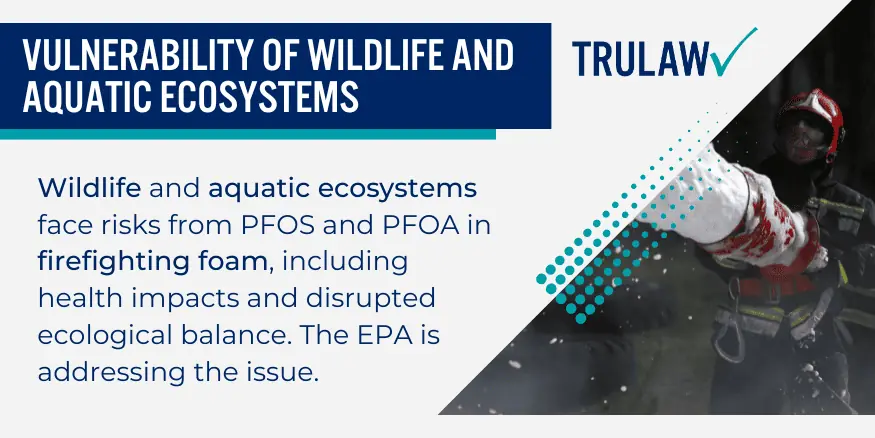
Birds, fish, amphibians, and other wildlife can be exposed to perfluorooctanoic acid (PFOA) and perfluorooctane sulfonate (PFOS) through contaminated water or by ingesting prey that has absorbed these fluorine-based chemicals.
This exposure can lead to reproductive problems, weakened immune systems, and even death.
The Fire Fighting Foam Coalition (FFFC) is actively addressing the issue of PFAS contamination in the environment.
As PFAS, including PFOA and PFOS, enters the food chain, it can bioaccumulate in top predators, further magnifying its effects on drinking water and fluorine levels.
Aquatic ecosystems suffer from increased vulnerability due to contamination from firefighting foam containing PFOS and PFOA.
The presence of these fluorine-based compounds disrupts natural processes within these ecosystems, affecting the growth and survival of various species.
It also poses a threat to sensitive habitats such as coral reefs and wetlands.
The EPA is taking action to address the issue.
How Firefighting Foams Work and Their Effectiveness in Extinguishing Fires
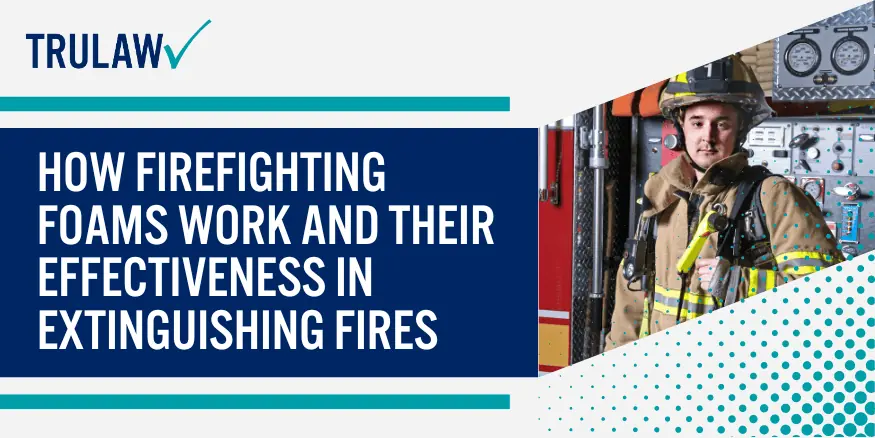
Firefighting foams, such as air force firefighting foams, play a crucial role in combating fires by smothering them and depriving them of oxygen.
These specialized foams, like PFOS and AFFF, are designed to efficiently suppress fires, depending on the type of fire they are intended to extinguish.
They contain fluorine, which enhances their effectiveness.
Smothering Fires with Firefighting Foams
Firefighting foams, such as air force firefighting foams, work by forming a thick blanket that covers the surface of the fire, effectively cutting off its oxygen supply.
This smothering action prevents the fire from spreading and intensifying.
By suppressing the oxygen, firefighting foams containing PFOS, AFFF, and PFOA starve the flames, leading to their gradual extinguishment.
What Are the Types of Firefighting Foams for Different Fires?
Different types of firefighting foams, including PFOS and PFOA, are used based on the class of fire they are meant to combat.
Class A fires involve ordinary combustible materials such as wood or paper, while Class B fires involve flammable liquids like gasoline or oil.
These foams contain fluorine, which helps extinguish the fires effectively.
The air force also relies on these foams for firefighting purposes.
For Class A fires, foam concentrates known as “Aqueous Film-Forming Foams” (AFFF) are commonly employed.
These AFFF firefighting foams have excellent wetting properties that allow them to penetrate porous materials and cool down the fuel source rapidly.
AFFF is effective in combating fires caused by PFOA and PFOS, which are chemicals commonly found in air force facilities due to their use in firefighting foam and other applications.
These foams contain fluorine compounds that help suppress fires and prevent re-ignition.
On the other hand, Class B fires require foam concentrates known as “Alcohol-Resistant Aqueous Film-Forming Foams” (AR-AFFF) alcohol-resistant foams.
These specially formulated foams can effectively combat liquid fuel fires without being compromised by alcohol-based fuels.
This is especially important for the Air Force, as they often deal with fires containing PFOA, PFOS, and other fluorine-based substances.
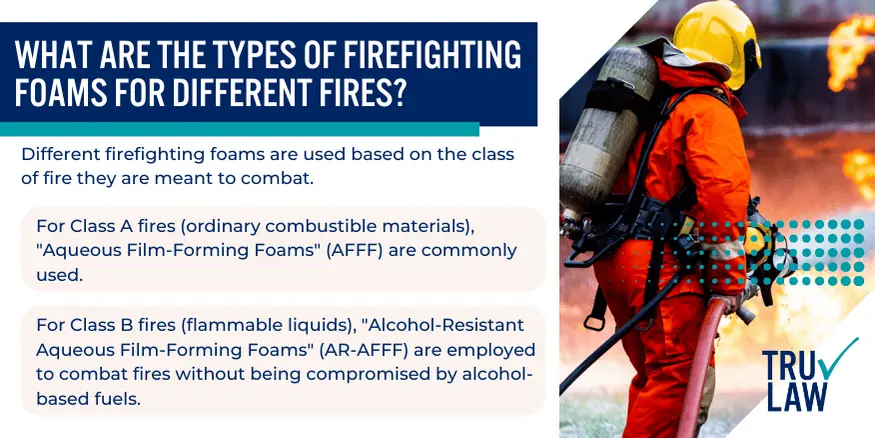
What Are The Threefold Effectiveness of Firefighting Foams?
The effectiveness of firefighting foams, such as PFOS and PFOA, used by the Air Force can be attributed to their ability to perform three essential functions: cooling, coating, and separating the fuel from oxygen.
These foams contain fluorine compounds that enhance their firefighting capabilities.
Here are the three (3) essential functions of firefighting foams:
1. Cooling: When applied to a fire, air force firefighting foam absorbs heat energy from the flames and surrounding environment.
This cooling effect helps reduce temperatures rapidly and prevents the re-ignition of fires caused by PFOS, fluorine, or AFFF.
2. Coating: AFFF Firefighting foams containing PFOS and PFOA create a protective layer that coats the fuel surface, preventing the release of flammable vapors and reducing the chances of reignition.
This fluorine-based coating action acts as a barrier between the fuel and oxygen, effectively interrupting the fire triangle.
3. Separating Fuel from Oxygen: By forming a thick foam blanket, firefighting foams physically separate the fuel source from atmospheric air.
This separation minimizes the availability of air required for combustion, thus inhibiting further fire growth.
The foam contains fluorine-based compounds such as PFOS and PFOA, which enhance its fire suppression capabilities.
Firefighters and navy fire departments rely on these three fundamental actions, free foam, AFFF, and air, to suppress fires effectively and prevent their rekindling.
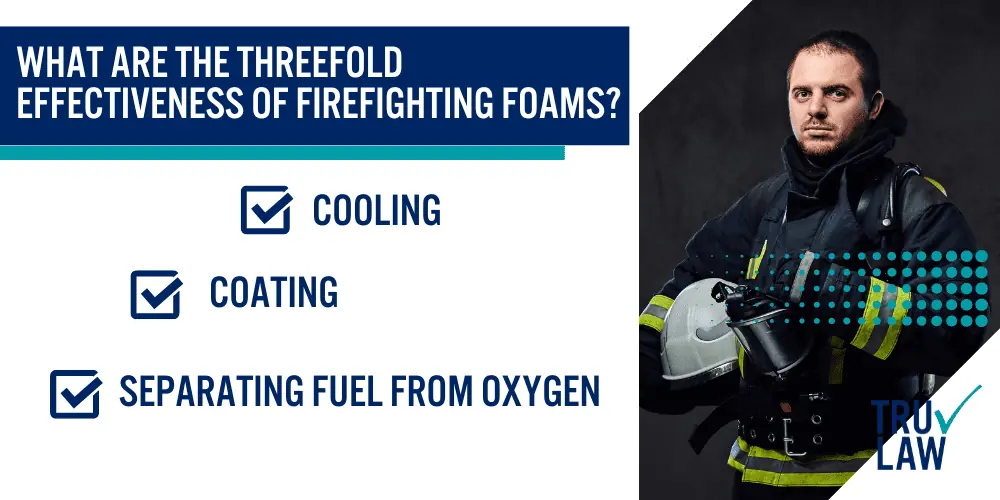
The Ongoing Issue of Toxic Firefighting Foam Use by the Military
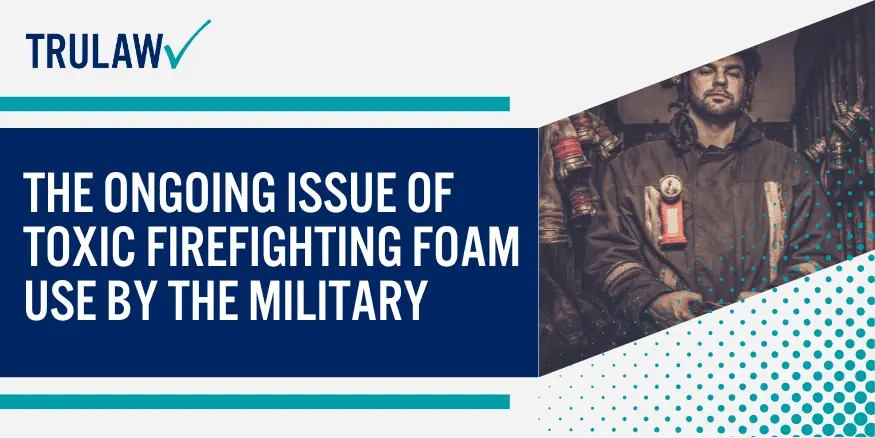
The Navy has long been a major user of firefighting foam, particularly for combatting liquid fuel fires and oil fires.
However, these foams containing PFOS and PFOA have come under scrutiny by the EPA due to their toxic nature and potential environmental impact.
One group of concern is per- and polyfluoroalkyl substances (PFAS), such as PFOA and PFOS, which are commonly found in firefighting foams used by the military.
These substances contain fluorine and have been identified as potential environmental contaminants by the EPA.
Military training exercises involving these navy foams, such as PFOS, have contributed to widespread contamination.
When responding to liquid fuel fires, such as those on naval vessels or military installations, firefighters often deploy firefighting foam containing fluorine to smother the flames.
This foam forms a thick blanket over the fire, effectively cutting off its oxygen supply and extinguishing it.
The EPA is actively addressing the issue of fluorine contamination.
However, when these firefighting foams containing PFOS and AFFF, also known as fluorine, are used repeatedly by fire departments during training exercises or in real-life situations, they can seep into the groundwater and contaminate nearby water sources.
Efforts are now being made by the military to phase out the use of toxic firefighting foams containing perfluorooctane sulfonate (PFOS) and other per- and poly-fluoroalkyl substances (PFAS).
The Air Force and Navy have recognized the need for change and have taken steps toward implementing safer alternatives that do not contain fluorine.
The Environmental Protection Agency (EPA) has also been involved in regulating the use of these foams, known as aqueous film-forming foams (AFFF).
The EPA and Navy are actively exploring options for free foam solutions that can effectively combat liquid fuel fires without posing significant risks to human health or the environment, specifically targeting PFOS.
The continued use of toxic firefighting foams, such as PFOS and AFFF, at military installations, including the Navy, has raised concerns about long-term effects on human health and ecosystems.
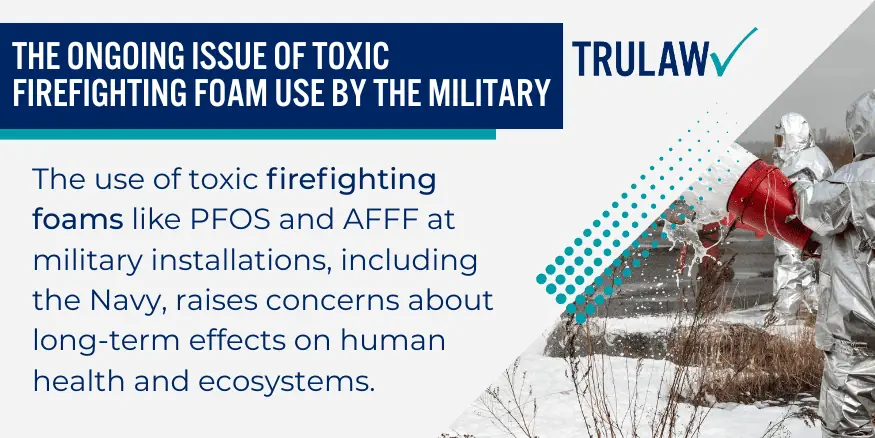
The presence of PFAS in groundwater near fuel storage areas or petroleum facilities poses a threat not only to service members but also to surrounding communities that rely on local water sources for drinking water.
These concerns have prompted the EPA to take action.
To address concerns about harmful chemicals like PFAS, rigorous testing protocols are being developed by the EPA to evaluate alternative firefighting agents such as free foam and AFFF.
These tests aim to ensure that any new products meet safety standards while providing effective fire suppression capabilities.
The United States Department of Defense is actively working towards implementing new military specifications that prioritize the use of PFAS-free firefighting foams, specifically perfluorooctanesulfonic acid (PFOS) and aqueous film-forming foam (AFFF).
This shift in defense procurement will not only safeguard the health and well-being of military personnel but also contribute to broader environmental protection efforts.
The Navy is leading the charge in adopting these new standards.
Reach out to us for a Free Consultation or utilize our chatbot to determine if you qualify for the Firefighting Foam Cancer Lawsuit.
The Environmental and Health Consequences of Toxic Firefighting Foam
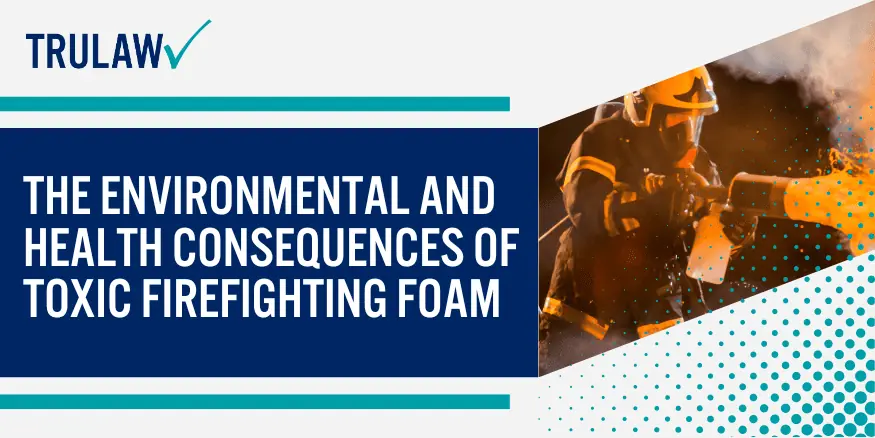
Exposure to PFAS-contaminated firefighting foam, such as PFOS and AFFF, can lead to adverse health effects in humans.
These chemical foams, commonly known as AFFF firefighting foam or simply foam, have been widely used by firefighters and the Navy for decades due to their effectiveness in extinguishing fires.
The EPA has raised concerns about the use of these foams due to their potential environmental impact.
However, the synthetic foams used by fire departments and the navy, such as Aqueous Film-Forming Foams (AFFF), contain per- and polyfluoroalkyl substances (PFAS) like PFOS, which have raised significant environmental concerns and health risks.
Contaminated water supplies pose risks for human consumption and wildlife habitats, especially when aqueous film-forming foam (AFFF) is used during fire suppression activities.
This foam can contaminate nearby water sources, including rivers, lakes, and groundwater reserves, affecting the Navy and its operations.
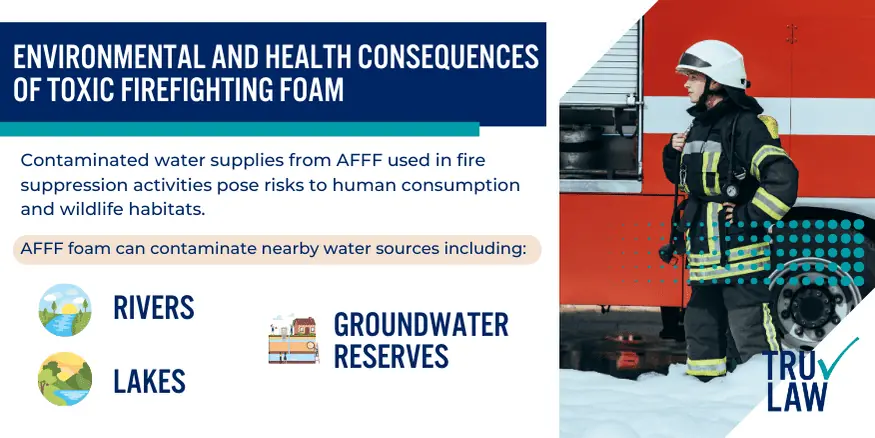
This contamination not only affects the availability of clean drinking water for communities but also poses a threat to aquatic ecosystems, including wildlife habitats.
Fire departments’ use of AFFF, or aqueous film-forming foam, containing PFAS chemicals can contribute to this issue.
The navy’s involvement with AFFF also plays a role in the contamination.
The persistent bioaccumulation of PFAS in organisms can disrupt ecosystems, including fire departments.
As these toxic chemicals enter the food chain through contaminated water sources, they accumulate in living organisms over time.
This bioaccumulation seriously threatens the balance and functioning of ecosystems, AFFF, and the Navy.
For example, predatory animals at the top of the food chain may consume smaller organisms containing high levels of PFAS, such as AFFF.
This accumulation can lead to reproductive issues, weakened immune systems, and other adverse effects on wildlife populations.
It is important for fire departments to consider the use of free foam, like the Navy does, to mitigate these risks.
The potential health hazards associated with exposure to firefighting foam, such as AFFF, are a cause for concern.
Research has shown that PFAS chemicals found in these foams have been linked to various health problems in humans, including those in the Navy.
One major concern for fire departments is the potential carcinogenic properties of AFFF.
Long-term exposure to PFAS, commonly used by the Navy, has been associated with an increased risk of certain firefighting foam cancers, such as kidney and testicular cancer.
These chemicals can affect liver function, disrupt hormone regulation, and impair immune system functionality.
The environmental impact of AFFF extends beyond immediate contamination incidents involving firefighting foam in the Navy.
Even after the AFFF has been used and the fire extinguished, its effects can persist in the environment.
The AFFF foam forms a finished foam layer that can seep into the soil, potentially contaminating it for extended periods.
This contamination poses risks not only to plants but also to animals that may come into contact with or consume contaminated vegetation.
The navy should be aware of these risks and take necessary precautions.
In response to concerns about PFAS-contaminated water supplies, health advisories have been issued regarding the use of firefighting foam containing AFFF and its impact on human health and the environment.
Efforts are underway to develop alternative foams that are less harmful, particularly for use by the Navy.
However, it is crucial for authorities and industries to take proactive steps in managing and mitigating the risks associated with AFFF, toxic firefighting foam.
The environmental and health consequences of toxic firefighting foam, such as AFFF, cannot be ignored.
It is imperative that we prioritize finding safer alternatives while also addressing existing contamination issues related to AFFF.
By raising awareness about the harmful effects of firefighting foam, implementing stricter regulations for its use, and investing in research for sustainable solutions, we can protect both human well-being and the delicate balance of our ecosystems from the harmful effects of AFFF.
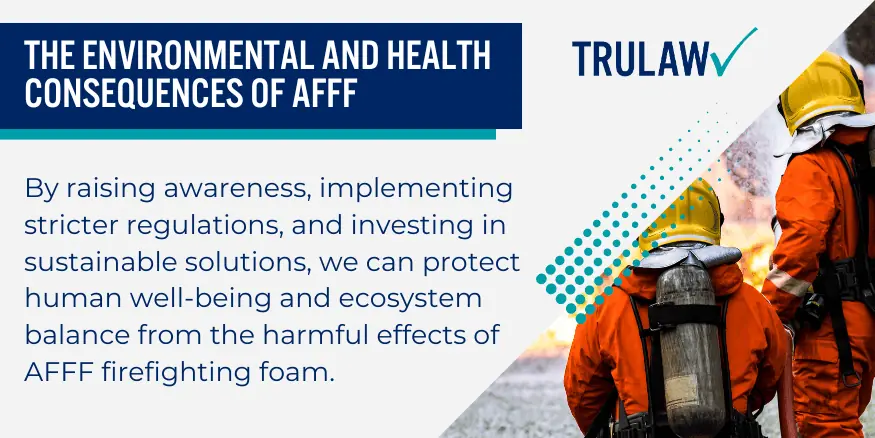
Addressing the Challenges of PFAS Contamination in Firefighting Foam
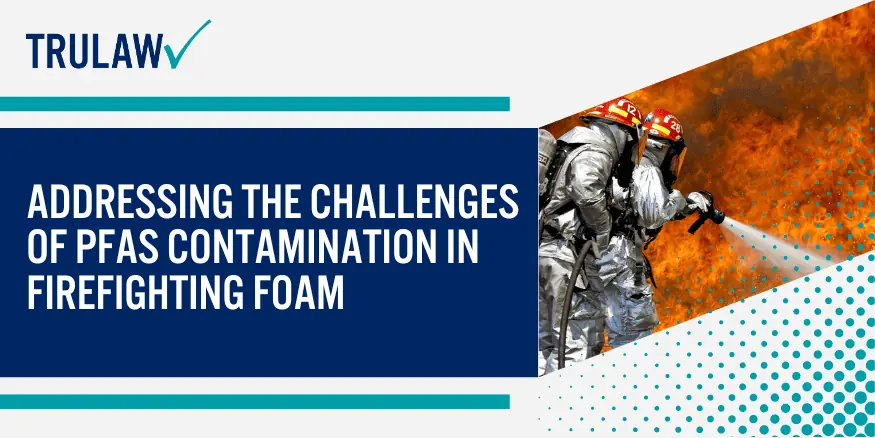
Developing alternative formulations for firefighting foam without harmful chemicals like AFFF is challenging.
Traditional firefighting foam solutions have long relied on the use of PFAS chemicals, specifically fluorinated surfactants, to combat fires involving polar solvent fires and substances effectively.
These fluorinated surfactants, known as AFFF, provide the necessary properties to form a stable and effective foam concentrate that can smother and suppress such fires. (foam stabilizers)
However, the presence of PFAS chemicals in firefighting foam has raised concerns due to their persistence in the environment and potential health risks.
As a result, researchers and manufacturers are actively working towards developing safer alternatives that do not compromise fire suppression capabilities.
One promising avenue explored is the development of fluoroprotein foam, which combines protein-based agents with small amounts of fluorinated surfactant.
This combination allows for effective extinguishing properties while reducing overall reliance on PFAS chemicals.
By utilizing this approach, firefighters can still benefit from the foam’s ability to spread rapidly across surfaces and create a barrier against heat transfer without introducing excessive amounts of potentially harmful substances.
Proper disposal methods for PFAS-contaminated firefighting foam need to be established.
Given their persistence in the environment, it is crucial to ensure that these foams are disposed of properly to prevent further contamination.
The challenge lies in finding suitable disposal techniques that effectively mitigate environmental impact while maintaining safety standards.
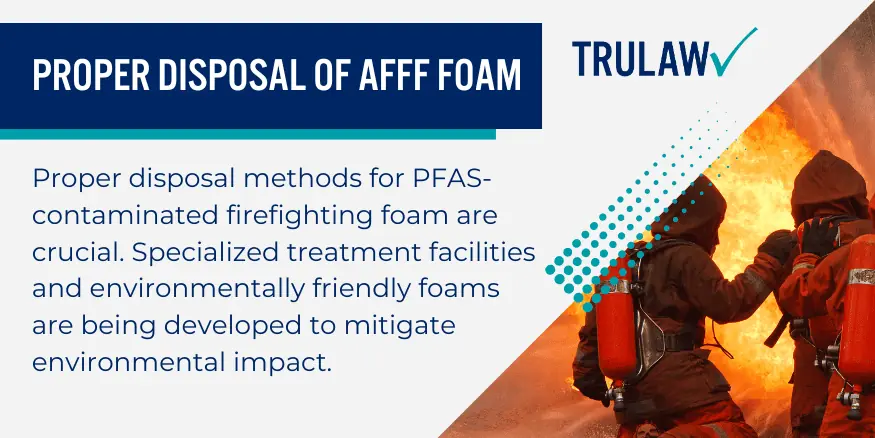
One option currently being explored is specialized treatment facilities equipped to handle PFAS-contaminated materials.
These facilities employ advanced technologies capable of breaking down or isolating PFAS compounds, rendering them less hazardous or removing them entirely from the waste stream.
Efforts are being made to develop more environmentally friendly foams that degrade naturally over time, reducing the need for specialized disposal methods altogether.
Remediation techniques are being explored to mitigate PFAS contamination in affected areas.
Areas, where firefighting foam containing PFAS has been used extensively may have experienced contamination of soil and water sources.
Addressing this issue requires the development and implementation of effective remediation strategies.
One approach involves the use of activated carbon filters to remove PFAS compounds from contaminated water sources.
These filters have a high affinity for PFAS chemicals, effectively trapping them as water passes through.
Another technique being explored is the application of chemical amendments to the soil, which can help break down or immobilize PFAS compounds, preventing their migration into groundwater.
If you or someone you care about has been exposed to AFFF or toxic firefighting foam and experienced health issues.
Contact an AFFF Cancer lawyer that can help you.
Get in touch with us for a free consultation!
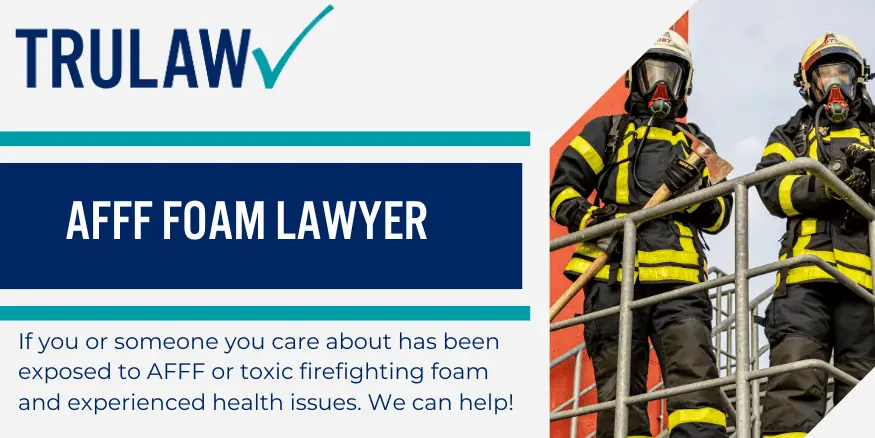
Regulations and Efforts to Reduce the Use of Toxic Firefighting Foam:
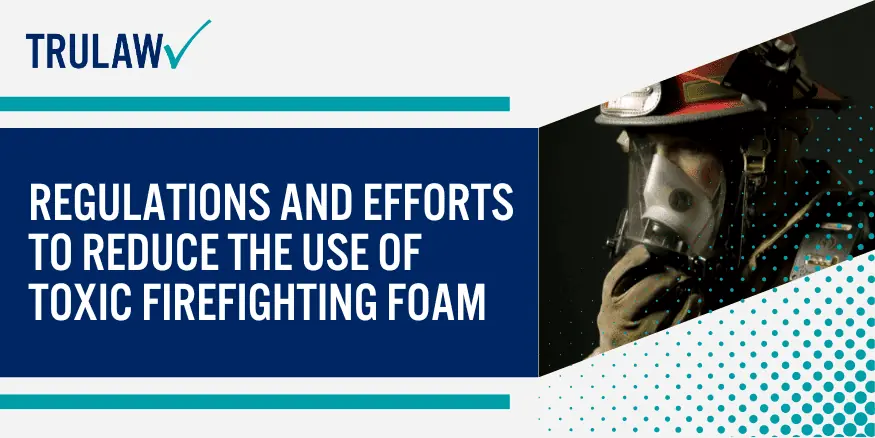
Governments and regulatory bodies are taking significant steps to address the environmental and health concerns associated with toxic firefighting foams.
This has led to the implementation of stricter regulations and the promotion of initiatives aimed at reducing their usage.
In response to growing awareness about the harmful effects of certain firefighting foams containing per- and poly-fluoroalkyl substances (PFAS) like AFFF cancer, some jurisdictions have taken decisive action by banning or restricting their use.
PFAS are fluorinated chemicals that have been widely used in fire suppression due to their effectiveness in extinguishing fires involving flammable liquid fires or fuels, such as jet fuel.
However, these chemicals are persistent in the environment and can accumulate in living organisms, posing risks to human health.
The Environmental Protection Agency (EPA) in the United States has been actively involved in regulating firefighting foam usage.
The agency has set safety levels for PFAS and is working towards establishing enforceable standards for drinking water.
The EPA is collaborating with industry stakeholders to develop safer alternatives that do not contain PFAS while maintaining effective fire suppression capabilities.
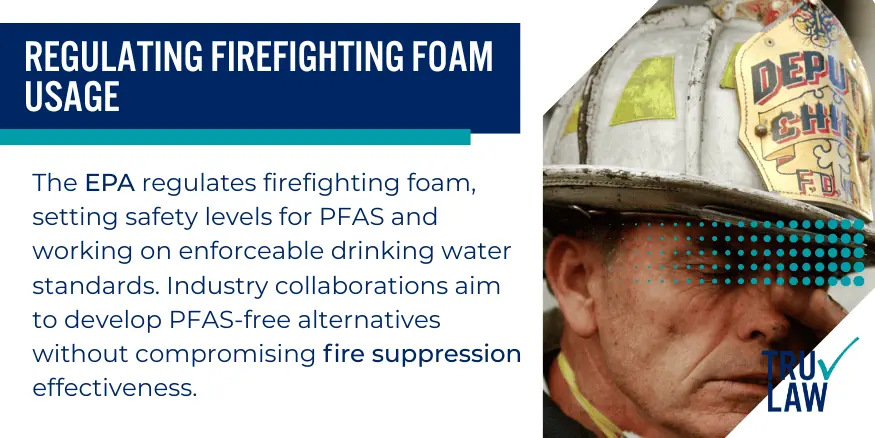
Industry initiatives are also playing a crucial role in reducing the use of toxic firefighting foams.
Manufacturers are investing in research and development efforts to create new foam formulations that are free from PFAS yet still provide effective fire suppression properties.
These advancements aim to ensure safety without compromising performance.
Furthermore, organizations like the Federal Aviation Administration (FAA) have been instrumental in driving change within their respective industries.
Recognizing the need for safer alternatives, FAA has prohibited airports from using aqueous film-forming foam (AFFF) for training purposes unless it is a qualified fluorine-free foam concentrate.
To promote responsible foam usage, guidelines have been established regarding proper storage tanks for firefighting foam products.
These guidelines emphasize preventing accidental releases into the environment while ensuring accessibility during emergencies.
By adhering to these standards, the risk of contamination can be minimized.
Efforts are also underway to develop new products that meet environmental and safety requirements.
Manufacturers are exploring alternative surfactants and chemicals that do not pose the same level of risk as PFAS-based foams.
These innovations aim to provide fire suppression solutions that effectively combat fires while minimizing harm to both human health and the environment.
Taking Action Against PFAS Contamination in Firefighting Foam
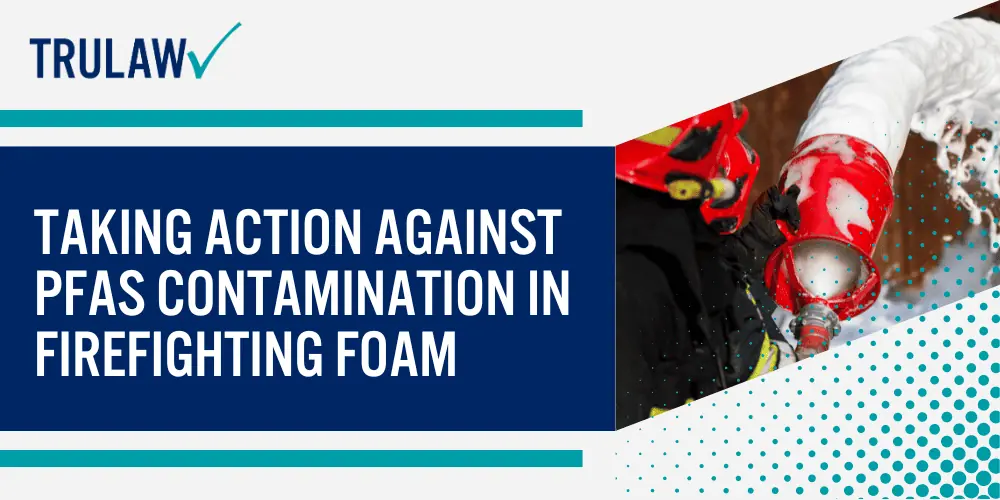
Efforts are underway to clean up contaminated sites and prevent further spread of PFAS.
The presence of per- and polyfluoroalkyl substances (PFAS) in AFFF foam has raised concerns about the potential impact on human health and the environment.
To address this issue, various initiatives have been launched to mitigate contamination and protect communities.
One crucial aspect is implementing health monitoring programs for individuals exposed to PFAS through firefighting foam.
These programs aim to track the long-term effects of exposure and provide necessary support to affected individuals.
Regular check-ups, blood tests, and other diagnostic measures are conducted to detect any adverse health outcomes associated with PFAS exposure.
By closely monitoring the health of those exposed, appropriate interventions can be initiated promptly.
Collaboration between government agencies, industries, and communities is paramount in addressing the issue of PFAS contamination in firefighting foam.
This multifaceted problem requires a collective effort from all stakeholders involved.
Government agencies play a vital role in setting regulations, conducting research, and providing resources for remediation efforts.
Industries that manufacture or use firefighting foam must take responsibility for their product’s environmental impact by adopting safer alternatives or improving existing formulations.
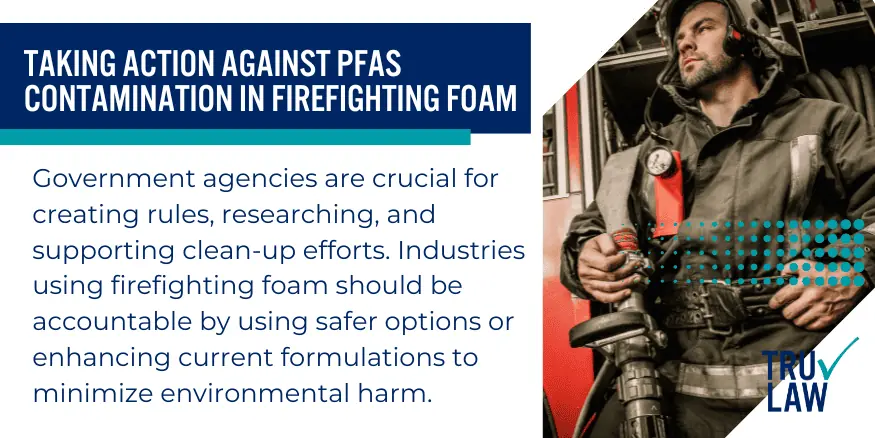
Communities also have a significant role to play in tackling PFAS contamination.
They can raise awareness about the issue among residents, advocate for stricter regulations, and actively participate in cleanup efforts.
Community-led initiatives such as organizing awareness campaigns or volunteering for cleanup activities contribute immensely to addressing the problem at a grassroots level.
To prevent further contamination of drinking water sources, steps are being taken to reduce the use of PFAS-containing firefighting foam.
Alternative foams that do not contain these harmful substances are being developed and implemented wherever possible.
Aqueous film-forming foams (AFFFs) without fluorine-based compounds are gaining popularity as they still possess fire suppression capabilities while posing minimal risk to the environment.
Companies are taking action by reformulating their firefighting foam products to eliminate or minimize PFAS content.
This proactive approach demonstrates their commitment to providing safer and more sustainable foam solutions.
By investing in research and development, these companies are striving to create effective protein foam concentrates that can effectively combat fires without compromising water quality.
One such innovative product is Bankshot, a protein-based firefighting foam concentrate developed by XYZ Company.
Bankshot offers an environmentally friendly alternative to traditional foams, reducing the risk of PFAS contamination while ensuring efficient fire suppression capabilities.
The move towards protein-based foams like Bankshot represents a significant step in addressing the PFAS contamination issue.
If you’re one of the victims of AFFF and PFAS, and thinking of filing an AFFF foam lawsuit, contact us!
Performance Comparison of Firefighting Foams
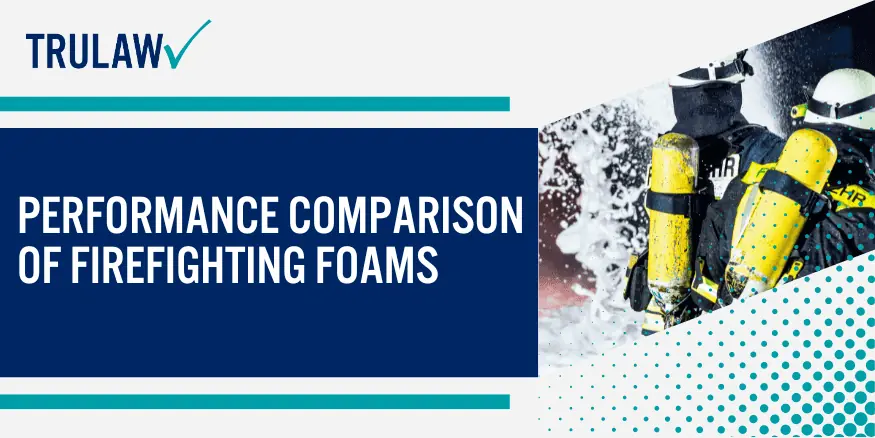
How to Compare the Performance of Firefighting Foams?
Different types of firefighting foams vary in their effectiveness against specific fire hazards.
Factors such as expansion ratio, drainage time, and burn-back resistance determine foam performance.
Extensive testing is conducted to ensure that firefighting foams meet industry standards.
Firefighting foams play a crucial role in combating fires by smothering them with a layer of foam that suppresses the flames and prevents re-ignition.
However, not all foams are created equal.
Understanding the performance characteristics of various firefighting foams is essential for selecting the right one for specific fire hazards.
Expansion Ratio
One important factor in assessing foam performance is its expansion ratio.
This refers to how much the foam expands when mixed with water and air during application.
Foam with a higher expansion ratio can cover a larger surface area, ensuring better fire suppression capabilities.
For example, protein foams typically have lower expansion ratios compared to other types of firefighting foams.
Drainage Time
The drainage time of firefighting foam is another critical aspect that affects its performance.
After application, the foam should remain stable on the surface and resist draining away quickly.
Longer drainage times allow the foam to provide extended coverage and maintain an effective barrier against re-ignition.
Foam streams with shorter drainage times may require more frequent reapplication to ensure continuous fire suppression.
Burnback Resistance
Firefighting foams must also demonstrate burn-back resistance, which refers to their ability to withstand exposure to heat without reigniting or breaking down rapidly.
Foams with high burn-back resistance can withstand intense heat conditions for longer durations, providing firefighters additional time for rescue operations or further extinguishing efforts.
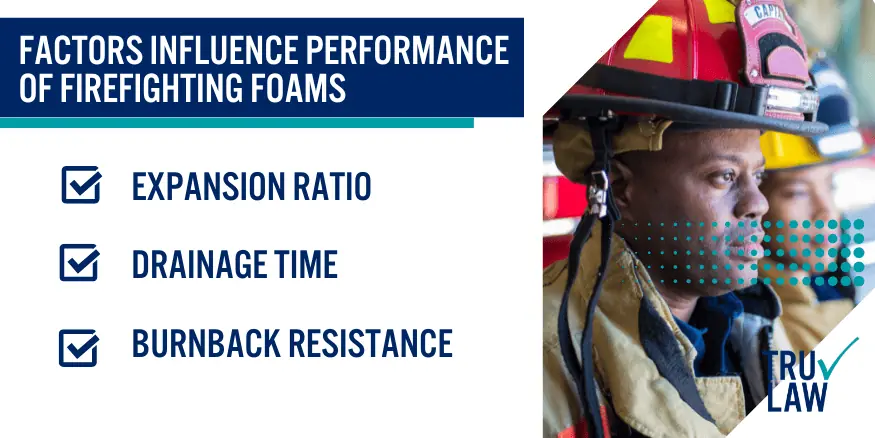
To ensure that firefighting foams meet industry standards and deliver optimal performance, rigorous testing procedures are carried out by organizations like the Fire Fighting Foam Coalition (FFFC).
These tests evaluate parameters such as expansion ratio, drainage time, burn-back resistance, and other performance factors.
Only foams that meet or exceed the established criteria are approved for firefighting operations.
Get in touch with us to learn more about the AFFF cancer lawsuit and get a free consultation.
Reducing the Use of Class B AFFF and Reporting Requirements
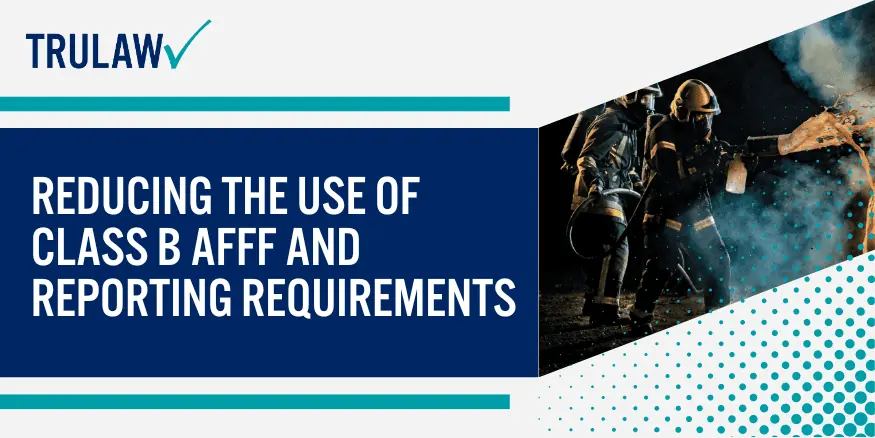
In conclusion, addressing the persistent environmental impact of firefighting foam is crucial.
Using toxic firefighting foam, particularly Class B AFFF, has led to severe consequences for the environment and human health.
The effectiveness of these foams in extinguishing fires cannot be denied, but their long-lasting effects have raised serious concerns.
The military’s continued use of toxic firefighting foam further exacerbates this issue.
Despite its efficacy in combating fires, the detrimental effects on ecosystems and communities cannot be overlooked.
It is imperative that we take action to mitigate these risks.
Regulations and efforts are being put in place to reduce the use of toxic firefighting foam.
By implementing stricter reporting requirements and monitoring systems, we can better track its usage and minimize its environmental impact.
This includes addressing the challenges associated with PFAS contamination in firefighting foam.
To combat PFAS contamination effectively, it is essential to adopt a proactive approach.
This involves investing in research and development for safer alternatives that do not pose significant environmental or health risks.
It is crucial to consider their performance comparison.
Understanding which options are more effective while minimizing harm can guide decision-making processes within fire departments and other organizations that utilize such foams.
In conclusion, reducing the use of Class B AFFF and implementing stringent reporting requirements are necessary steps toward mitigating the environmental and health consequences associated with toxic firefighting foam.
By taking action now, we can protect our ecosystems, safeguard public health, and ensure a safer future for all.
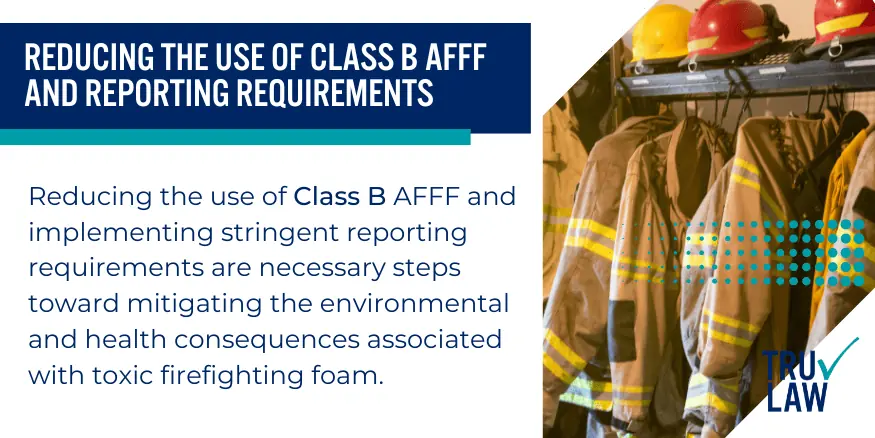
If you or someone you care about has been exposed to AFFF or toxic firefighting foam and experienced health issues.
As a result, you might be eligible to pursue legal action.
Reach out to us for a Free Consultation or utilize our chatbot to determine if you qualify for the Firefighting Foam Lawsuit.
At TruLaw, we are a reliable source of information for individuals seeking to understand the potential side effects associated with drugs, medical devices, and chemicals their loved ones use.
Our team collaborates with skilled firefighting foam attorneys ready to advocate for those adversely affected by these substances and other products.
AFFF Lawsuit Frequently Asked Questions
-
What Are the Types of Firefighting Foams for Different Fires?
Different types of firefighting foams, including PFOS and PFOA, are used based on the class of fire they are meant to combat.
Class A fires involve ordinary combustible materials such as wood or paper, while Class B fires involve flammable liquids like gasoline or oil.
These foams contain fluorine, which helps extinguish the fires effectively.
The air force also relies on these foams for firefighting purposes.
For Class A fires, foam concentrates known as “Aqueous Film-Forming Foams” (AFFF) are commonly employed.
These AFFF firefighting foams have excellent wetting properties that allow them to penetrate porous materials and cool down the fuel source rapidly.
AFFF is effective in combating fires caused by PFOA and PFOS, which are chemicals commonly found in air force facilities due to their use in firefighting foam and other applications.
These foams contain fluorine compounds that help suppress fires and prevent re-ignition.
On the other hand, Class B fires require foam concentrates known as “Alcohol-Resistant Aqueous Film-Forming Foams” (AR-AFFF) alcohol-resistant foams.
These specially formulated foams can effectively combat liquid fuel fires without being compromised by alcohol-based fuels.
This is especially important for the Air Force, as they often deal with fires containing PFOA, PFOS, and other fluorine-based substances.
-
What Are The Threefold Effectiveness of Firefighting Foams?
The effectiveness of firefighting foams, such as PFOS and PFOA, used by the Air Force can be attributed to their ability to perform three essential functions: cooling, coating, and separating the fuel from oxygen.
These foams contain fluorine compounds that enhance their firefighting capabilities.
Here are the three (3) essential functions of firefighting foams:
1. Cooling: When applied to a fire, air force firefighting foam absorbs heat energy from the flames and surrounding environment.
This cooling effect helps reduce temperatures rapidly and prevents the re-ignition of fires caused by PFOS, fluorine, or AFFF.
2. Coating: Firefighting foams containing PFOS and PFOA create a protective layer that coats the fuel surface, preventing the release of flammable vapors and reducing the chances of reignition.
This fluorine-based coating action acts as a barrier between the fuel and oxygen, effectively interrupting the fire triangle.
3. Separating Fuel from Oxygen: By forming a thick foam blanket, firefighting foams physically separate the fuel source from atmospheric air.
This separation minimizes the availability of air required for combustion, thus inhibiting further fire growth.
The foam contains fluorine-based compounds such as PFOS and PFOA, which enhance its fire suppression capabilities.
Firefighters and navy fire departments rely on these three fundamental actions, free AFFF foam, AFFF, and air, to suppress fires effectively and prevent their rekindling.
-
How to Compare the Performance of Firefighting Foams?
Different types of firefighting foams vary in their effectiveness against specific fire hazards.
Factors such as expansion ratio, drainage time, and burn-back resistance determine foam performance.
Extensive testing is conducted to ensure that firefighting foams meet industry standards.
Firefighting foams play a crucial role in combating fires by smothering them with a layer of foam that suppresses the flames and prevents re-ignition.
However, not all foams are created equal.
Understanding the performance characteristics of various firefighting foams is essential for selecting the right one for specific fire hazards.
Expansion Ratio
One important factor in assessing foam performance is its expansion ratio.
This refers to how much the foam expands when mixed with water and air during application.
Foam with a higher expansion ratio can cover a larger surface area, ensuring better fire suppression capabilities.
For example, protein foams typically have lower expansion ratios compared to other types of firefighting foams.
Drainage Time
The drainage time of firefighting foam is another critical aspect that affects its performance.
After application, the foam should remain stable on the surface and resist draining away quickly.
Longer drainage times allow the foam to provide extended coverage and maintain an effective barrier against re-ignition.
Foam streams with shorter drainage times may require more frequent reapplication to ensure continuous fire suppression.
Burnback Resistance
Firefighting foams must also demonstrate burn-back resistance, which refers to their ability to withstand exposure to heat without reigniting or breaking down rapidly.
Foams with high burn-back resistance can withstand intense heat conditions for longer durations, providing firefighters additional time for rescue operations or further extinguishing efforts.
To ensure that firefighting foams meet industry standards and deliver optimal performance, rigorous testing procedures are carried out by organizations like the Fire Fighting Foam Coalition (FFFC).
These tests evaluate parameters such as expansion ratio, drainage time, burn-back resistance, and other performance factors.
affOnly foams that meet or exceed the established criteria are approved for firefighting operations.
Get in touch with us to learn more about the AFFF cancer lawsuit and get a free consultation.

Managing Attorney & Owner
With over 25 years of legal experience, Jessica Paluch-Hoerman is an Illinois lawyer, a CPA, and a mother of three. She spent the first decade of her career working as an international tax attorney at Deloitte.
In 2009, Jessie co-founded her own law firm with her husband – which has scaled to over 30 employees since its conception.
In 2016, Jessie founded TruLaw, which allows her to collaborate with attorneys and legal experts across the United States on a daily basis. This hypervaluable network of experts is what enables her to share the most reliable, accurate, and up-to-date legal information with our readers!
Additional AFFF Lawsuit resources on our website:
Here, at TruLaw, we’re committed to helping victims get the justice they deserve.
Alongside our partner law firms, we have successfully collected over $3 Billion in verdicts and settlements on behalf of injured individuals.
Would you like our help?
At TruLaw, we fiercely combat corporations that endanger individuals’ well-being. If you’ve suffered injuries and believe these well-funded entities should be held accountable, we’re here for you.
With TruLaw, you gain access to successful and seasoned lawyers who maximize your chances of success. Our lawyers invest in you—they do not receive a dime until your lawsuit reaches a successful resolution!
AFFF Lawsuit claims are being filed against manufacturers of aqueous film-forming foam (AFFF), commonly used in firefighting.
Claims allege that companies such as 3M, DuPont, and Tyco Fire Products failed to adequately warn users about the potential dangers of AFFF exposure — including increased risks of various cancers and diseases.
Depo Provera Lawsuit claims are being filed by individuals who allege they developed meningioma (a type of brain tumor) after receiving Depo-Provera birth control injections.
A 2024 study found that women using Depo-Provera for at least 1 year are five times more likely to develop meningioma brain tumors compared to those not using the drug.
Suboxone Tooth Decay Lawsuit claims are being filed against Indivior, the manufacturer of Suboxone, a medication used to treat opioid addiction.
Claims allege that Indivior failed to adequately warn users about the potential dangers of severe tooth decay and dental injuries associated with Suboxone’s sublingual film version.
Social Media Harm Lawsuits are being filed against social media companies for allegedly causing mental health issues in children and teens.
Claims allege that companies like Meta, Google, ByteDance, and Snap designed addictive platforms that led to anxiety, depression, and other mental health issues without adequately warning users or parents.
Transvaginal Mesh Lawsuits are being filed against manufacturers of transvaginal mesh products used to treat pelvic organ prolapse (POP) and stress urinary incontinence (SUI).
Claims allege that companies like Ethicon, C.R. Bard, and Boston Scientific failed to adequately warn about potential dangers — including erosion, pain, and infection.
Bair Hugger Warming Blanket Lawsuits involve claims against 3M — alleging their surgical warming blankets caused severe infections and complications (particularly in hip and knee replacement surgeries).
Plaintiffs claim 3M failed to warn about potential risks — despite knowing about increased risk of deep joint infections since 2011.
Baby Formula NEC Lawsuit claims are being filed against manufacturers of cow’s milk-based baby formula products.
Claims allege that companies like Abbott Laboratories (Similac) and Mead Johnson & Company (Enfamil) failed to warn about the increased risk of necrotizing enterocolitis (NEC) in premature infants.
Here, at TruLaw, we’re committed to helping victims get the justice they deserve.
Alongside our partner law firms, we have successfully collected over $3 Billion in verdicts and settlements on behalf of injured individuals.
Would you like our help?
